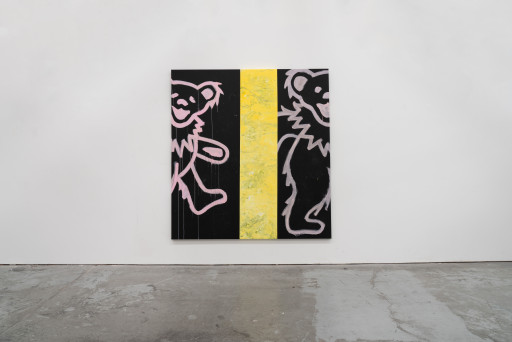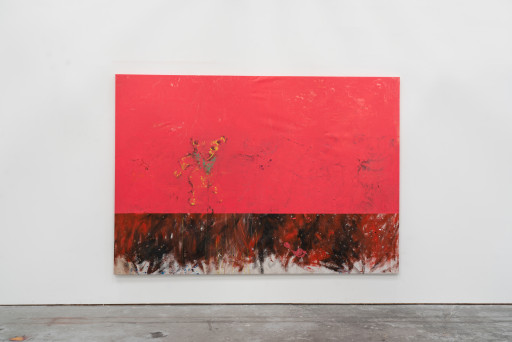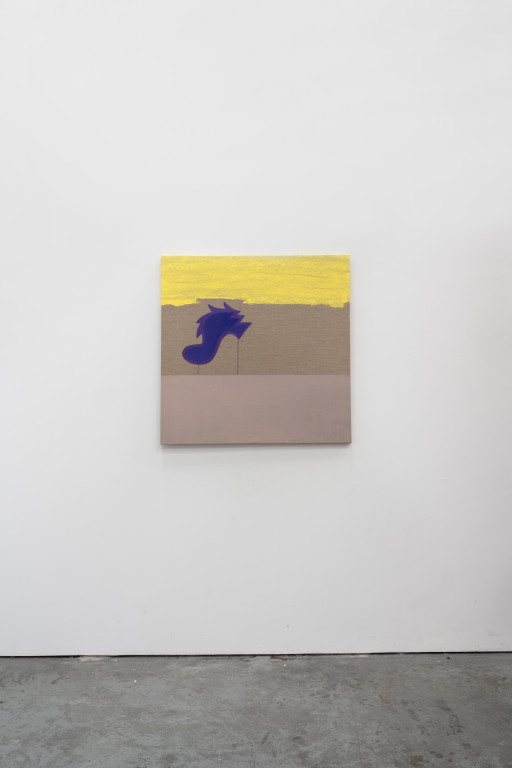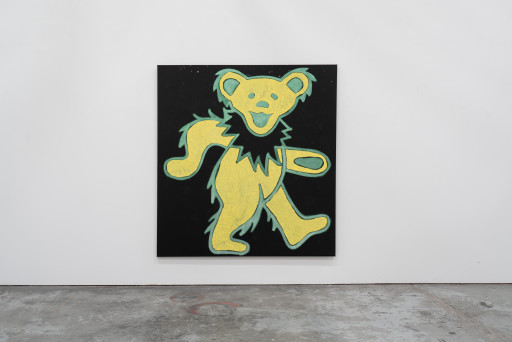June 23, 2021
Tina Braegger and Jordan Stein in conversation on the occasion of the artist's first solo exhibition in San Francisco titled History of the Grateful Dead.
Jordan Stein (JS): Tina! Where are you? And what’s that tiny bear in the background?
Tina Braegger (TB): I'm in my dad's office at my parents' house. That's not something I have in my own house (laughs). I gave this to him a few years ago when I was in art school, and he hung it behind his desk, where it still is.
JS: There are a lot of artists who live with their own work, which I've always thought is a little weird.
TB: Yes, that is haunting (laughs).
JS: If you made that in art school, then you've been working with the bears for nearly a decade?
TB: The first time I came across the bear was in 2011. My dad listened to the Grateful Dead when I was younger, but I wasn't aware of the bear until my friends made flyers with it on them, to advertise a party where they were dj-ing, and I thought the bear looked funny. I found different versions of the bear when I researched it a little and I started collecting them. I found new versions online every day from the Deadheads, who uploaded images of T-shirts, bumper stickers, and badges to their webstores.
The piece behind me is the very first bear I ever did. It's an inkjet print on watercolor paper. After that I decided to print on canvas. The images I had collected were small, thumbnail-sized, and when I made them bigger, they got all pixelated. I was working with Photoshop, and there was a filter called the Oil Painting Brush, that I used to re-render the image. But I had a bug in my Photoshop version at that time, and the Oil Painting Brush made the painting look nothing like an oil painting. It gave the picture a psychedelic look, like a visual translation of a chemically induced hallucination.
I did that for one year or so, and when I updated my Photoshop, I could no longer make those 80 x 90 cm paintings because the bug was fixed. I then made a collection of all the bears I've ever printed and put them together in a picture book. The book with the title The Grateful Dead was published in 2013 by Forde.

Tina Braegger, Slouching towards Bethlehem, 2021. Oil on canvas, 76 3/4 x 110 1/4 inches. Installation view.
JS: It's funny to be talking to you because I'm a curator who happens to have the dubious and potentially unhelpful distinction of being really into the Grateful Dead. So I can either do this conversation well or terribly. But I came to the band after moving to California, and they're so embedded in California mythology. I'm curious about your work appearing here in the United States for the first time, and not in Europe, where you live. I assume you've become something of a scholar—you know where this iconography comes from, you've entertained a million questions about it, you've cruised through setlists and album lists to come up with the titles of the paintings.
TB: As far as I can judge, I’d say so far you’re doing rather well.
Somebody once said to me, "You don't have to be into the Dead to be a Deadhead." So, I guess I am that kind of a Deadhead.
JS: What do you mean?
TB: There are many things surrounding the Grateful Dead, but, specifically, it's the bear that I find fascinating. I never listened to the music. And I think making a distinction regarding Deadheads who listen to the music is important, as that is obviously the most important aspect.
JS: You sound a little "Dead-agnostic." Like you'll take or leave the actual band, which is sort of wonderful because you spend your time surrounded by their iconography. How did you get hooked on the bear? I've read that you were interested in it as a symbol, completely divorced from its context that could be sort of played, invented, or re-invented in an infinite number of ways. As you likely know, the Grateful Dead had a relationship with the idea of "open-source" before the internet and with regards to their fan's recording and trading shows. So in a way, you're a Grateful Dead superfan.
TB: I guess so. At one point, after I couldn't continue to make those smaller inkjet paintings we talked about, I started thinking more about the bear and where it comes from. For the first time, I realized a certain disconnect between the name of the band and the colorful psychedelic bear. That is when I wrote a little novel.
JS: A Grateful Dead novel??
TB: Sort of. It is titled The Grateful Dead-- a diary by Gabriel Krampus and the first edition was published by Beckbooks in 2015. In the meantime Hacienda Books published a second edition. It is a little more than 100 pages. The book is structured so that there is running text on one page, and on the opposite page are footnotes. They all refer to literature that I made up. The bear itself does not really appear in the book; it’s function is more the one of a signifier. It's a fictional diary of an 84-year old man called Gabriel Krampus, who lives on an uninhabited island together with his wife, who has been buried up to her neck in the sand for over 44 years—only her head with her long white hair sticks out. They went to this island and buried the wife in the sand because that's what she wanted, and he's an artist and always wanted to have less worldly distractions to be able to focus on his work; so a little more than 44 years ago, he agreed to make her wish come true.
In the beginning, the couple lives happily ever. And then one day, there is a big thunderstorm, and the wife almost drowns because she can't move. But the storm stops, and she survives, and they realize a lot of things are damaged, so the protagonist needs to go to the main island to buy supplies.
When he goes to the mainland, he meets a young woman from Austria, with the name Esmeralda, and they start talking. She returns with the protagonist to the lonely island, where she starts a conversation with the protagonist's wife. Esmeralda tells the older woman about a recurring hallucination or vision of a psychedelic, colorful marching or dancing bear. The wife says, "Well, you must be referring to the Grateful Dead bear—it goes back to ancient Greek mythology, where it was known as the god Efcharisto Thanatos—or to the Romans, Gratus Mort.” And then the book gets into made-up mythology. It's mostly fictional, but some things are true. Like the biblical story from the Book of Tobit and the Tibetan Book of the Dead is in there. At one point, the bear reappears as the unofficial logo of the Grateful Dead, and later in another fake-history-book-footnote, it becomes the first comic figure to be president of the United States, before a black person or a woman does.
JS: Holy moly.
TB: I think writing the novel was an attempt to make sense of the relationship between the band and the bear. I did it for myself, to establish my own reference system, my own arrangement.
JS: It sounds pretty surrealist. How much did you think about the book's relationship to something that might translate into "meaning" and how much was "crack your head open and see what comes out and everybody's free to make their own sense of it"?
TB: I figure the novel is pretty surrealist. I like your question, because it is about an important aspect of making art in general. It is what intrigued me so much about the relationship of the symbol of the bear and the band—if you know the Grateful Dead, and you know the history of the band, of course, it makes sense. But if you are not aware of that narrative, how do you connect the name of the band with a psychedelic bear?
The word “accident” or “coincidence” is important in this context—how I came across the bear and how I just decided to stick with it. And how the Photoshop feature was not quite working, and how that became the actual artwork. For me, it's always like this—it's always more of a coincidence or accident, and then meaning falls into place.

Tina Braegger, No Country for Old Men, 2021. Detail. Oil on canvas, 78 3/4 x 72 7/8 inches. Installation view.
JS: Not to be annoying, but what you've just described is very in line with the Grateful Dead philosophy. The cosmos is more extraordinary than we can possibly imagine, and we're just dancing on the head of a pin: How extraordinary that we're here at all. I feel as if your paintings had a cool, conceptual agenda, the situation might be too dissonant; they wouldn't play well.
TB: When you make art, you can never manipulate your audience because you never know who they are or where they're coming from. That is one aspect, and another one is that everything we do is just a repetition of what has always been here. I think the Grateful Dead bear is a connecting point of those aspects which from there opens up to potential possibilities. The frame of the bear is always the same thing. Do you know what I mean?
JS: In a way, it's a blank slate...
TB: Right. The total white canvas moment doesn't really exist because it's always a bear, yet it's a blank slate because I always have to come up with a new bear.
JS: But it's amazing that you stuck with it, given that you learned more and more about its actual history, context, and stakeholders, who can be pretty intense. Did you ever think: “I've got to get the heck out of here!”?
TB: I mean, always. Every now and then, I think: “What the fuck am I doing? I go to my studio every day, and I paint the same stupid bear over and over again.”
JS: (laughs) It's like every artist I know!
TB: I think so, yeah. It is a metaphor for making art. Or for life.
JS: How did the process change from Photoshop to paint?
TB: After I finished the novel, I made a few bear flags, lightboxes, and a forty square meter bear cut into a cornfield. Then I asked myself, "Am I just going to exercise the bear through every medium, and if so, how interesting is that?"
To paint the bear makes sense because the symbol or motive of the bear is neither figurative nor abstract—I mean, of course, it's figurative because it's recognizable as a bear, but it has no body; it has no depth. It's super flat—it works on a screen or a flag—and it also works on a painting.
JS: It's an icon.
TB: Yeah, it's an icon. It has no voice and no gender, and it was never animated. It's kind of devoid of content; I can fill it up with my own. Whatever I'm interested in can go into the next painting.

Tina Braegger, We Contain Multitudes, 2021. Detail. Oil on canvas, 78 3/4 x 72 7/8 inches. Detail.
TB: A third publication I made after the picture book and the novel, is a coloring book (The Grapefruit Bear, published 2019 by Hacienda Books). I was inspired by my kids, who I had to take to the studio every now and then: I printed out bears for them so they could color them in. I collected their drawings, and at one point, I thought it would make sense to make our own coloring book using their drawings. The idea was to make a book that is interactive, something the viewer can participate in, something inclusive.
JS: That's the big idea. But, of course, Deadheads are a self-selecting group. I mean, whether you like it or not, it's a lot of white people dancing in open fields. How open is it—really? It's not exactly a monoculture, but it's certainly not as diverse as it sees itself or aspires to be.
TB: That was something that I was thinking about a lot. What is the moral position of the bear? The interesting thing is that it is absolutely amoral—it's not not moral, but it has this switch that was there since it came to life in the 70s. This switch, or double standard, is something that is characteristic for any time and also for the American counterculture of the '70s. There was Charles Manson and his killers, and on the other hand were the hippies, which were people with idealist ideas. And of course, all those things age—some of them well and others not so well—and idealist ideas evolve, and political ideas change. I think that is interesting because it is a vehicle to travel through time and see what changed and what is the same, what is resolved, and what is still an issue. There still are Deadheads who come up with bootleg merch, silk-screened shirts, and stitched hats. And then you have a company like Nike buying the rights for a Dead-themed sneaker that is over $2,000. There is a certain moral ambiguity within the bear as such a recognizable icon.
JS: It seems to me that the Dead iconography now is more abundant than ever before—it's licensed like crazy. How do you view this weird marketplace?
TB: I don't know if I am hypersensitive, but it was really different ten years ago. One could never imagine H&M making Grateful Dead t-shirts. In a way, it became a mechanism that kept itself going. It's as if the bear came to life like artificial intelligence—it’s a cyborg, and it’s about to take over the world.
JS: I think the band had an expectation that if their fans were not attempting to reap creepy profits from tapes or t-shirts, then they should have at it. It was kind of like “open-source” morality.
TB: The word “open-source” is important in regards to the band, but also the bear and my work. John Perry Barlow, a behind-the-scenes Grateful Dead lyricist, published The Declaration of the Independence of the Internet at the World Economic Forum in Davos, Switzerland, in 1996. It is as if the trading, the back and forth of the bear, paved the way for the internet. And it’s also interesting that Bob Thomas, the artist who came up with the bear, had appropriated it in the first place; it was not originally the Grateful Dead’s bear. To quote Jesi Khadivi, who recently wrote a text about my work: the bear is the original copy. It's found footage. I appropriate it, and by taking it out of its context, its meaning shifts.
JS: And then, at some point, the band sells a license to Zara or something. What does it feel like to make this work for a context in which an audience can view, talk, evaluate, critique, and acquire it?
TB: I think it's a super interesting question, but I don't know. As an artist, I don't think my position is quite comparable to that of a big company, like H&M, Zara, or Nike.
People who don't know the band see t-shirts with bears on them, and they ask me, is that your bear on that shirt? And in a way, it is. But on a bigger scale, It is also an unpaid advertisement for the band, and I think that was a very important factor in their success.
JS: Yeah, we forget that they were the most successful touring act for years. How do you feel about bringing the work to Northern California? Are you excited? Are you nervous?
TB: Both, but mostly I'm very sad that I won't be there. It feels like a full circle, a homecoming of a kind, to finally bring the bear back to where it came to life.

Tina Braegger, We Contain Multitudes, 2021. Detail. Oil on canvas, 78 3/4 x 72 7/8 inches. Detail.
JS: What are you showing?
TB: We made a selection of four paintings. For this exhibition, I was working with a very fresh color palette, with a poppy pink and a lime yellow. I was inspired by the cover of the Sex Pistols album, Never Mind the Bollocks. One of the paintings is a little larger than the usual two square meter, it is something like 2 x 3 m. I've had that canvas in my studio for three years and I just kept painting over it, and the painting got worse and worse. And then, at one point, there was a fire on it with five little bears burning, and it was so cheesy, it didn't work at all. So I just over-painted it with pink. And now it is one of my favorite paintings I ever made.
JS: Tell me more about the actual process in the studio. Is it like a coloring book?
TB: I didn't start as a painter. I made the first bear paintings in 2016. After I finished the novel, I was thinking about how to keep working with the bear and how to make it my own. And somehow, to translate that into a painting made so much sense because it's physical—the canvases are larger than I am. Most of them are two square meters, some up to 3 x 5 m or 2 x 7 m. It's a physical experience, an almost performative act of creating something larger than me. And the longer I stick with it, the more I learn about painting.
JS: So, after doing it for a number of years, you're a painter.
TB: Yeah, I think so. There was this thing that a friend of mine said to me when I finished art school: "Now you have to think about what kind of artist you want to be." And I was thinking, what is this guy even talking about? But now, more and more, I realize what he meant, and I guess I am the kind of artist who just goes to her studio every day and spends a couple of hours there and thinks about the bears and makes her paintings.
JS: And when you are working on particular paintings, do you work from sketches? Do you have preconceived ideas? Is it totally intuitive?
TB: I have a loose idea and make a loose sketch. I mostly dig into a topic by exploring it through working serially. There was a series in which I was thinking about backgrounds, there was the warp series, and there was the diffused series. At one point, I was thinking about the most popular pop artists, and I made bears in the style of Lichtenstein, Keith Haring, and Andy Warhol, and then as a more conceptual approach, Elaine Sturtevant.
For my last exhibition, I realized that many versions of the bears, which the fans made, had typical elements of a 70s aesthetic, like sun, moon, stars, or clouds, or sometimes mountains or waters, or leaves and flowers. It's landscape elements, and I took the elements out of the bears and placed them in the background of the paintings.
You might imagine it's limiting, but it's very freeing, especially during this whole pandemic. How free do we want to be? What kind of regulations are we happy with? What is the promise of freedom, and what are the dangers of it?
The more I paint, the further away I get from the origin. I was thinking about the title for this exhibition—I was thinking of calling it The History of the Grateful Dead, which was the title of the album released in 1973, where the bears appeared for the first time. They were intended as a reference to Owsley (Bear) Stanley, who was the sound engineer for the album, and an LSD producer, who made LSD for consumers in San Francisco at the time. It's important when you look at history to examine perspective. My history of the Grateful Dead only overlaps scarcely with the history of the Grateful Dead's Grateful Dead.
JS: I think that'll work. The gallery is probably two miles, two and a half miles, from the house where they lived, where the band started.
Tina Braegger (b. 1985, Lucerne) finished her MA in Fine Art in 2015 at Ecal in Lausanne. She lives and works in Berlin and Zurich and teaches at the BA Fine Art program at Ecal. Upcoming exhibitions are Let‘s dance, a two person exhibition with Sturtevant, curated by Udo Kittelmann at de 11 Lijnen in Belgium in 2021 and a solo exhibition at the Neuer Essener Kunstverein in Essen in 2022. Recent exhibitions include Lose Enden, Kunsthalle Bern, Bern (2021) and Ich werde hier sein im Sonnenschein und im Schatten, Société, Berlin (2020). Her exhibition History of the Grateful Dead runs from July 8 - August 20, 2021 at Friends Indeed Gallery, San Francisco.
Jordan Stein is a curator based in San Francisco and the author of Rip Tales: Jay DeFeo’s Estocada and Other Pieces (Soberscove Press, 2021, forthcoming). He operates Cushion Works, a space for exhibitions and events, serves as programs curator at KADIST, and has independently organized exhibitions at Berkeley Art Museum & Pacific Film Archive, Artists Space, Yale Union, The Renaissance Society at the University of Chicago, San Francisco City Hall, Philip Johnson’s Glass House, Matthew Marks Gallery, and more.



